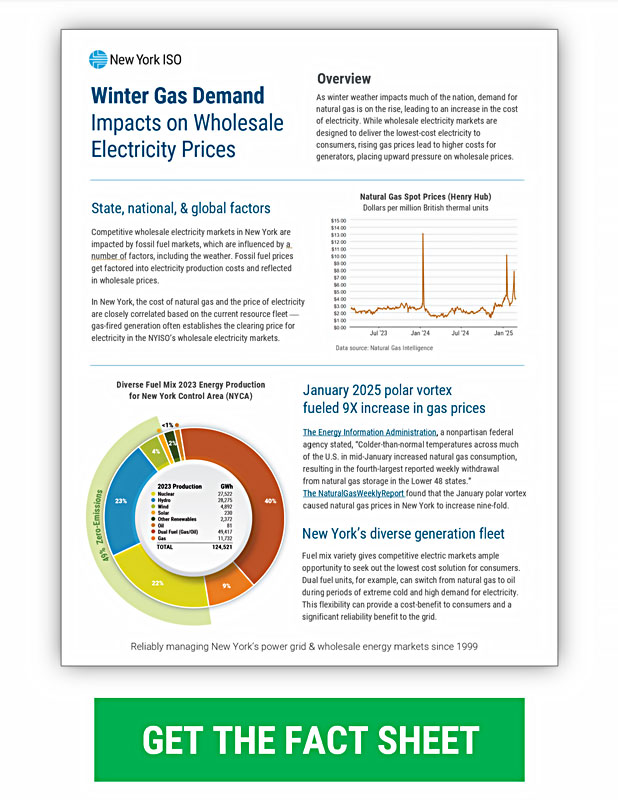Demand for Natural Gas Is Up, Impacting Electricity Prices in New York

As winter weather continues to impact much of the nation, demand for natural gas is on the rise, leading to an increase in the cost of electricity for New York consumers.
That’s because generators that use natural gas in the production of electricity experience price spikes and factor those increases into their production costs.
The New York Independent System Operator (NYISO) administers the state’s competitive, wholesale markets where the price of electricity is established. The wholesale price of electricity, which can fluctuate month to month, is determined by several factors including market forces, weather, and operating conditions on the high-voltage electric system.
While the NYISO does not oversee the natural gas system, the price of natural gas can have a significant impact on the price for electricity, as we’ve experienced this winter.
“We’ve certainly seen an increase in the day ahead and real time price for electricity the last several weeks,” said Aaron Markham, NYISO Vice President of Operations, whose job is focusing on maintaining reliability of the high voltage electric system. “A large part of that increase is due to the rise in natural gas prices. We have several measures in place to ensure the markets are seeking the most efficient cost solutions.”
The country’s pipeline network is a highly integrated system that moves natural gas throughout the continental United States, with millions of miles of pipelines that link natural gas production and storage facilities with New York consumers and power plants.
According to the Energy Information Administration, a nonpartisan federal agency serving as the nation’s primary source of energy data, demand by residential and commercial customers using natural gas for space heating rose significantly in recent weeks as severe cold weather swept the nation.
As reported in their NaturalGasWeeklyReport, released February 12, 2025, the January polar vortex caused natural gas prices in New York to increase nine-fold. “Colder-than-normal temperatures across much of the United States in mid-January increased natural gas consumption, resulting in the fourth-largest reported weekly withdrawal from natural gas storage in the Lower 48 states.” according to the EIA analysis.
Other elements that factor into electricity costs include the increased expense of maintaining and upgrading aging power plants, investments in much-needed transmission and distribution equipment, and investments in renewable energy sources intended to support the state’s climate policies. Inflation has also contributed to higher electricity prices, as the cost of materials and labor has risen across industries.
While the NYISO cannot control the cost of natural gas or electricity, we monitor market participants’ buying and selling behavior to keep the electric system reliable and as cost-efficient as possible for consumers. As Josh Boles, NYISO Director of Market Mitigation and Analysis put it, "At the end of the day, electric markets are here to ensure consumers are getting reliable power at the least cost. We make sure entities are following the market rules.”
The NYISO’s Market Mitigation and Analysis (MMA) team examines data on market transactions and operating behaviors of generating assets to verify that consumer prices reflect competitive market circumstances. If they detect anomalies or a trend that raises questions, they have authority to investigate and request additional information from market participants.
MMA team members regularly crisscross the state to visit generators and observe their operations first-hand. This helps team members understand and analyze trading or bidding behavior in the markets.
In administering the competitive electric markets, the NYISO is held to strict oversight by federal and state regulation and must comply with several statewide and regional reliability requirements. The NYISO must ensure that least-cost solutions to provide electricity are balanced with consumer demand – especially when demand rises during extreme cold.
As electricity prices rise and more attention is paid to how the electric system works, it’s important to understand the two main parts of the typical electric bill: 1) the delivery portion, charged by electric utilities, and approved by the New York State Public Service Commission, and 2) the supply portion, which is determined by the market price of electricity. Supply in this case refers to the electricity produced by power plants. Those plants might be powered by fossil fuels or nuclear, or renewable energy like wind, solar and hydro.
New York is fortunate to be served by several generation types. This diverse generation fleet gives the competitive electric markets ample opportunity to seek out the lowest cost solution for consumers. Dual fuel units, for example, can switch from natural gas to oil as a generating fuel during periods of extreme cold and high demand for electricity. This flexibility can provide a cost-benefit to consumers and a significant reliability benefit to the grid.
However, competitive wholesale electricity markets in New York are also impacted by national and global fossil fuel markets, conditions that are factored into the costs to produce electricity, which are reflected in wholesale electricity prices and in supply charges seen in consumer bills.
To be clear, the NYISO does not set the price of electricity. The NYISO’s role is to oversee the wholesale markets and ensure that buyers and sellers operate within the markets according to rules and regulations determined by the Federal Energy Regulatory Commission, other regulatory bodies, and state and regional reliability organizations.
As we have for 25 years, the NYISO will continue to actively manage the impact of the cold weather on the grid throughout the winter season.

